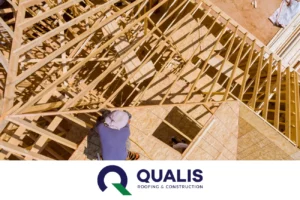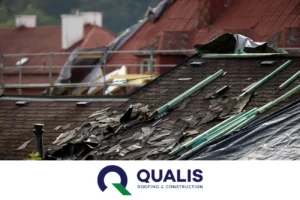Think of it like your roof’s skeleton. It isn’t the fancy shingles or the flashing everyone sees – roof decking is the sturdy layer underneath it all. It’s what holds your roof together, keeps it strong, and makes sure everything sits right where it should. Whether you’re a pro roofer or a homeowner dealing with repairs, understanding roof decking is key. Let’s dive in and get you in the know.
What Is a Roof Deck? What Is Roof Sheathing?
To put it simply: roof decking (or roof sheathing) is like a big, flat sheet that goes over your roof’s framing (think of the rafters and joists like your roof’s bones). This sheet gives you a solid base to nail down everything else – your underlayment, your shingles, all that good stuff.
Mostly, you’ll see roof decking made of plywood or OSB (that stands for oriented strand board). It’s got to be tough enough to handle the weight of your roof, plus anything Mother Nature throws at it – rain, snow, hail, even the occasional curious squirrel up there. Decking also gives your roof some serious muscle – it helps keep the whole system rigid and strong, so you don’t end up with sags or dips during a storm.
So, what is a roof deck? Think of it like this: your decking is the foundation your roof is built on. A good, solid deck makes for a roof that stands strong for years to come.
Roof Deck Materials
You’ve got a few choices when it comes to decking, and what’s best can depend on your roof and your budget. Here’s the lowdown on the most popular options:
- Plywood: Plywood roof decking is the old-school champ. Plywood is made from thin layers of wood glued together, making it strong and stable. It’s a good all-around choice for a lot of roofs.
- OSB (Oriented Strand Board): This is the workhorse of modern roof decking. It’s made from wood chips and glue pressed together. OSB is often cheaper than plywood and holds up great in most situations.
- Metal: Yes, you can use metal for decking! It’s strong and fire-resistant, making it a good fit for commercial buildings or areas with strict fire codes. It tends to be pricier than wood options, though.
A Note for the Pros: Sometimes, you may come across stuff like concrete or gypsum board decking, especially on flat roofs or specialty projects. But for most roofers, it’s plywood, OSB, and maybe the occasional metal job.
Roof deck materials come in several shapes and sizes. It’s up to you to decide what’s best for you.
Things to Know Before You Hire
Decking work isn’t always a walk in the park. Here’s what to keep in mind, whether you’re a homeowner tackling a DIY project or a roofer looking to find the right crew: any high-quality roof installation service provider will tell you that you have to look at the bigger picture.
Bad decking often means there are problems underneath. Issues such as water damage and rot can spread to the framing. Be ready for the possibility that you won’t just be replacing a few sheets!
What’s more, permits, codes, and safety are all important as well. Falls are a huge risk. Make sure you or whoever you hire follows safety guidelines to the letter – harnesses, hard hats, the whole nine yards. Depending on where you live, you might need permits for roof work, especially if you’re looking at more than just repairs. Check with your local building department before you start tearing things up.
Wrapping Up
So, there you have it! Now you’re in the loop about what roof decking is, and why using materials like plywood roof decking is so important.
Whether you’re tackling a roof repair yourself or talking shop with a contractor, knowing about decking makes a difference. It’s one of those hidden parts of your roof that can cause big headaches if it gets ignored.
Got a question about your roof’s decking or need an expert to take a look? That’s where Qualis Roofing & Construction come in. Give us a shout, and we’ll make sure your roof is built on a rock-solid foundation.









